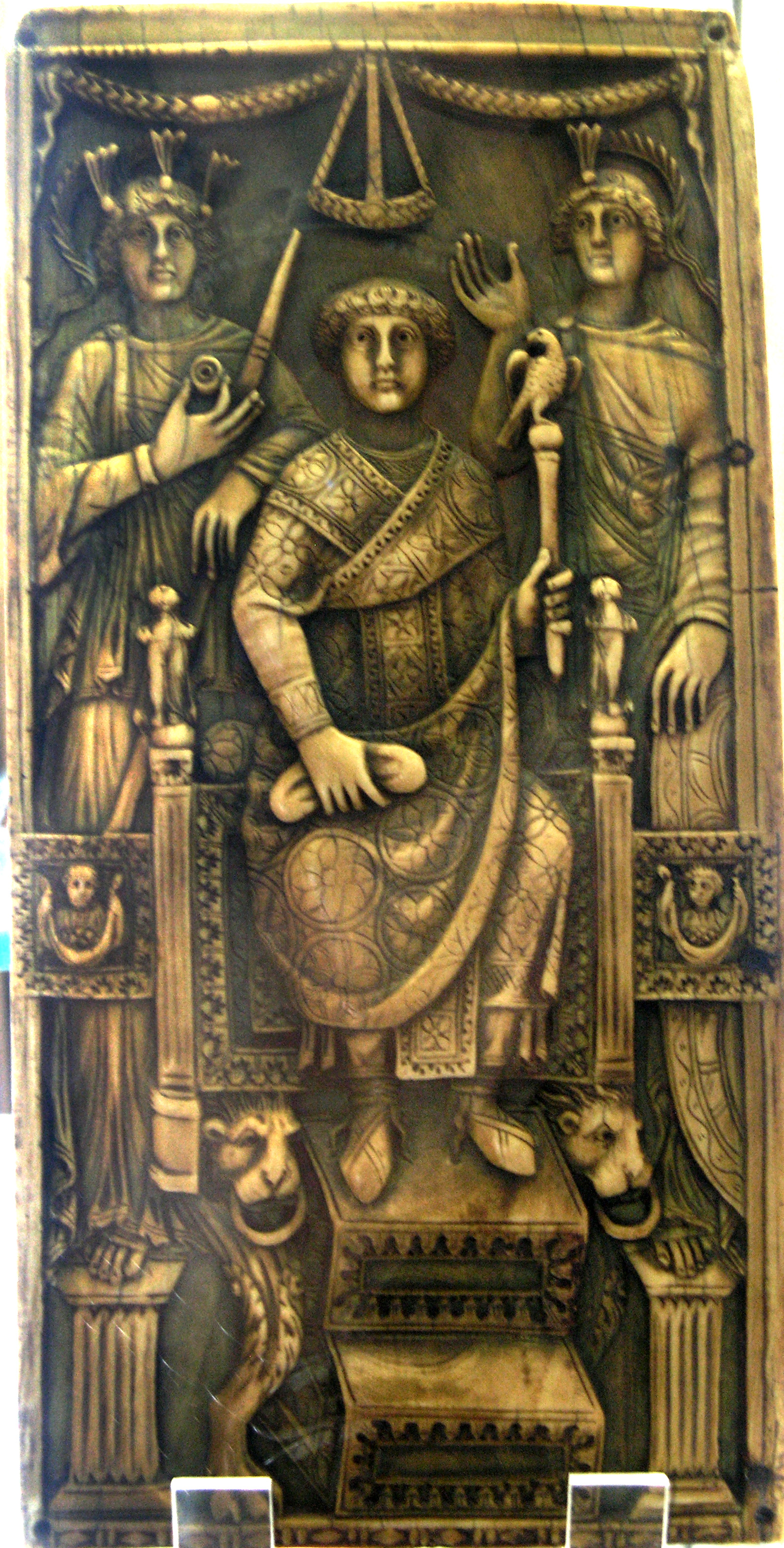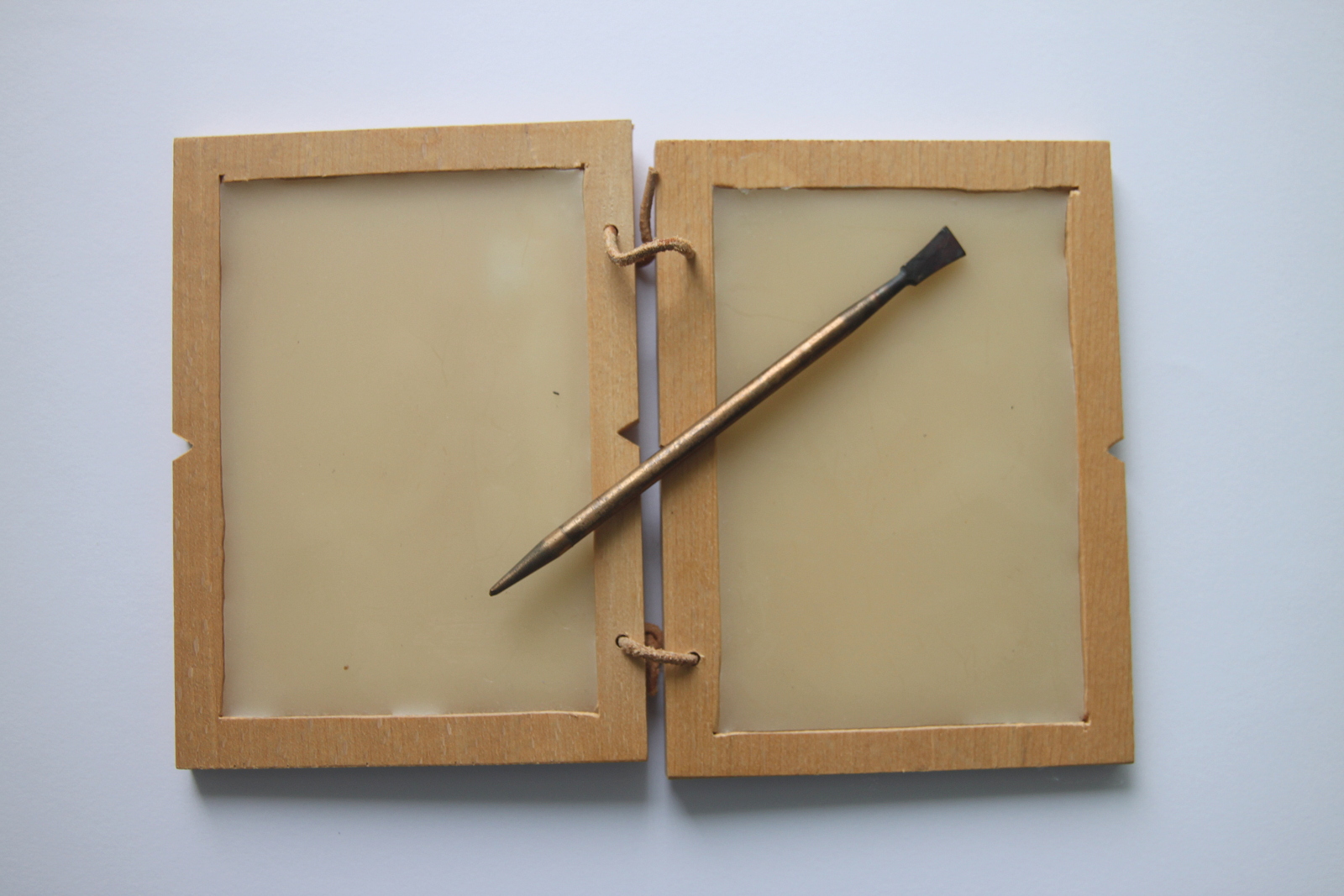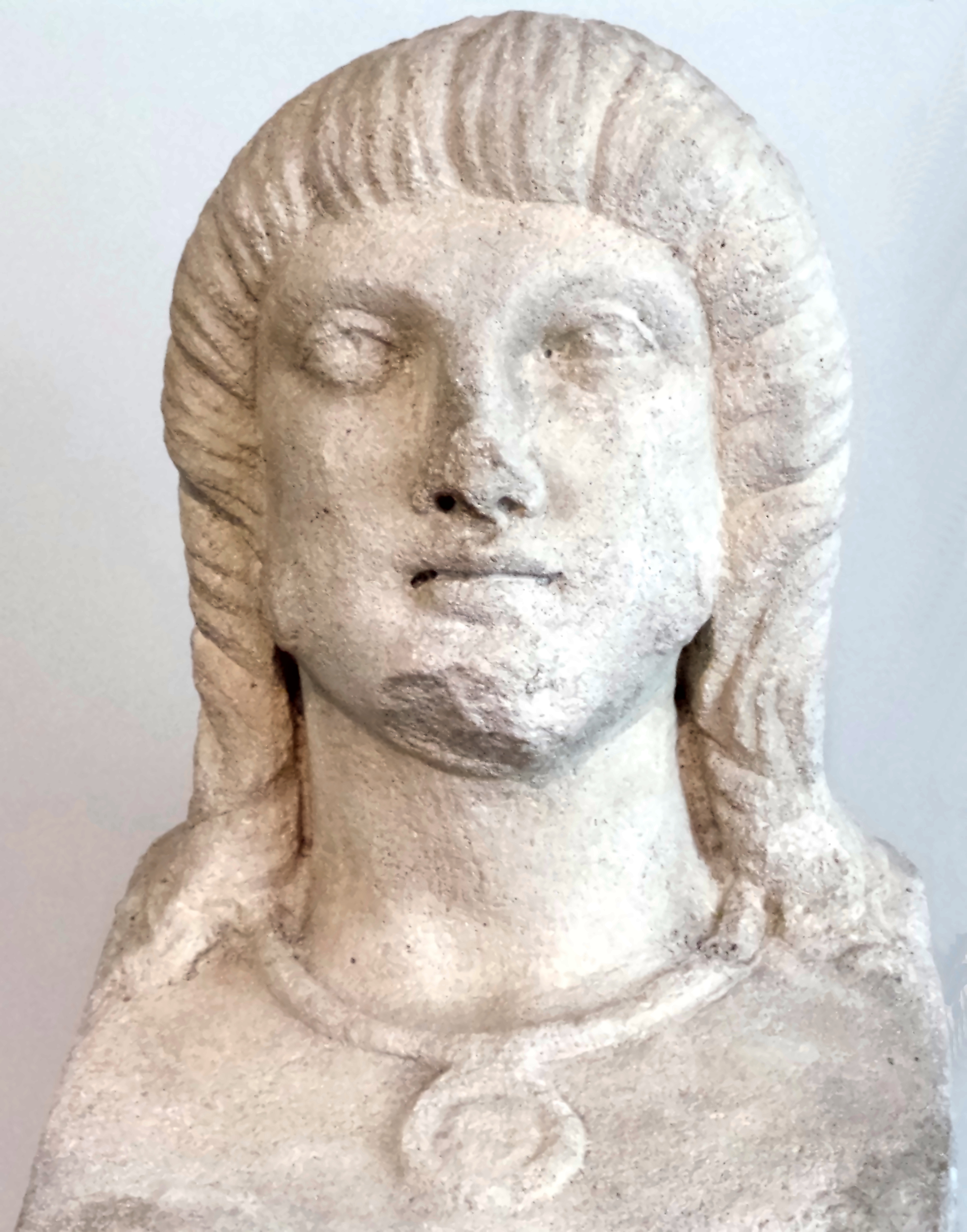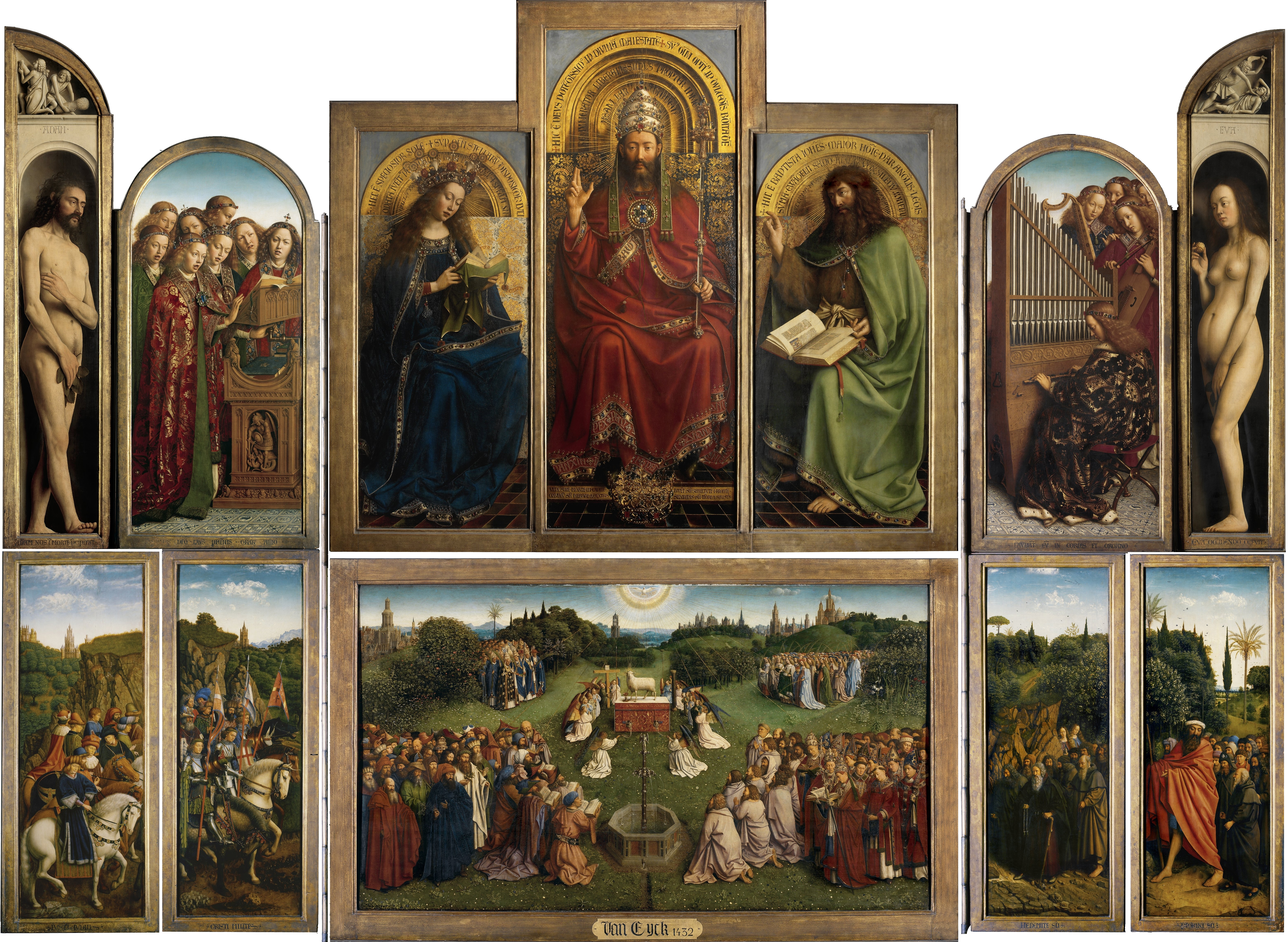|
Diptych
A diptych (, ) is any object with two flat plates which form a pair, often attached by a hinge. For example, the standard notebook and school exercise book of the ancient world was a diptych consisting of a pair of such plates that contained a recessed space filled with wax. Writing was accomplished by scratching the wax surface with a stylus. When the notes were no longer needed, the wax could be slightly heated and then smoothed to allow reuse. Ordinary versions had wooden frames, but more luxurious diptychs were crafted with more expensive materials. Etymology The word ''diptych'' is borrowed from the Latin , which itself is derived from the Late Greek () . is the neuter plural of () . Art ] As an art term a diptych is an artwork consisting of two pieces or panels that together create a single art piece. These can be fastened together or presented adjoining each other. In medieval times, panels were often hinged so that they could be closed and the artworks protected. ... [...More Info...] [...Related Items...] OR: [Wikipedia] [Google] [Baidu] |
Consular Diptych
In Late Antiquity, a consular diptych was a type of diptych intended as a de-luxe commemorative object. The diptychs were generally in ivory, wood or metal and decorated with rich relief sculpture. A consular diptych was commissioned by a ''consul ordinarius'' to mark his entry to that post, and was distributed as a commemorative reward to those who had supported his candidature or might support him in the future. History Origins From as early as the first century CE, some formal letters of appointment to office were known as "codicilli", little books, two or more flat pieces of (usually) wood, joined by clasps, lined with wax on which was written the letter of appointment. Later, the letter might be written on papyrus and presented within the covers. By the late fourth century, however, specially-commissioned diptychs began to be included among the gifts that appointees to high office distributed to celebrate and publicize the public games that were their principal duties. ... [...More Info...] [...Related Items...] OR: [Wikipedia] [Google] [Baidu] |
Diptych Areobindus Louvre OA9525
A diptych (, ) is any object with two flat plates which form a pair, often attached by a hinge. For example, the standard notebook and school exercise book of the ancient world was a diptych consisting of a pair of such plates that contained a recessed space filled with wax. Writing was accomplished by scratching the wax surface with a stylus. When the notes were no longer needed, the wax could be slightly heated and then smoothed to allow reuse. Ordinary versions had wooden frames, but more luxurious diptychs were crafted with more expensive materials. Etymology The word ''diptych'' is borrowed from the Latin , which itself is derived from the Late Greek () . is the neuter plural of () . Art ] As an art term a diptych is an artwork consisting of two pieces or panels that together create a single art piece. These can be fastened together or presented adjoining each other. In medieval times, panels were often hinged so that they could be closed and the artworks protect ... [...More Info...] [...Related Items...] OR: [Wikipedia] [Google] [Baidu] |
Diptych Barberini Louvre OA9063 Whole
A diptych (, ) is any object with two flat plates which form a pair, often attached by a hinge. For example, the standard notebook and school exercise book of the ancient world was a diptych consisting of a pair of such plates that contained a recessed space filled with wax. Writing was accomplished by scratching the wax tablet, wax surface with a stylus. When the notes were no longer needed, the wax could be slightly heated and then smoothed to allow reuse. Ordinary versions had wooden frames, but more luxurious diptychs were crafted with more expensive materials. Etymology The word ''diptych'' is Loanword, borrowed from the Latin , which itself is derived from the Late Greek () . is the neuter plural of () . Art ] As an art term a diptych is an artwork consisting of two pieces or panels that together create a single art piece. These can be fastened together or presented adjoining each other. In medieval times, panels were often hinged so that they could be closed and the a ... [...More Info...] [...Related Items...] OR: [Wikipedia] [Google] [Baidu] |
Early Netherlandish Painting
Early Netherlandish painting is the body of work by artists active in the Burgundian Netherlands, Burgundian and Habsburg Netherlands during the 15th- and 16th-century Northern Renaissance period, once known as the Flemish Primitives. It flourished especially in the cities of Bruges, Ghent, Mechelen, Leuven, Tournai and Brussels, all in present-day Belgium. The period begins approximately with Robert Campin and Jan van Eyck in the 1420s and lasts at least until the death of Gerard David in 1523,Spronk (1996), 7 although many scholars extend it to the beginning of the Dutch Revolt in 1566 or 1568 – Max J. Friedländer's acclaimed surveys run through Pieter Bruegel the Elder. Early Netherlandish painting coincides with the Early and High Renaissance, High Italian Renaissance, but the early period (until about 1500) is seen as an independent artistic evolution, separate from the Renaissance humanism that characterised developments in Italy. Beginning in the 1490s, as increasing n ... [...More Info...] [...Related Items...] OR: [Wikipedia] [Google] [Baidu] |
Poet And Muse Diptych
The Poet and Muse diptych is a Late Antique ivory diptych that appears to commemorate, and to flatter, the literary pursuits of the aristocrat who commissioned it, so that it stands somewhat apart from the consular diptychs that were carved for distribution to friends and patrons when a man assumed the consular dignity during the later Roman Empire. The original inscription in this example, unusually, will have been carried out on the borders of the reverse side, which was infilled with a layer of wax for writing on, the ivory diptych being a very grand example of a wax tablet; the inscription has not survived, so there can be no way to identify the writer for whom it was made. In the literature that has accumulated about this diptych, various prominent figures have been offered as candidates: Ausonius, Boethius, and Claudian, and even earlier figures, like Ennius and Seneca, with whom the donor wished to be associated The muse represented is Erato, muse of lyric poetry, with ... [...More Info...] [...Related Items...] OR: [Wikipedia] [Google] [Baidu] |
Byzantine Art
Byzantine art comprises the body of artistic products of the Eastern Roman Empire, as well as the nations and states that inherited culturally from the empire. Though the empire itself emerged from the decline of Rome, decline of western Rome and lasted until the Fall of Constantinople in 1453, the start date of the Byzantine period is rather clearer in art history than in political history, if still imprecise. Many Eastern Orthodox states in Eastern Europe, as well as to some degree the Islamic states of the eastern Mediterranean, preserved many aspects of the empire's culture and art for centuries afterward. A number of contemporary states with the Eastern Roman (Byzantine) Empire were culturally influenced by it without actually being part of it (the "Byzantine commonwealth"). These included Kievan Rus', as well as some non-Orthodox states like the Republic of Venice, which separated from the Byzantine Empire in the 10th century, and the Norman-Arab-Byzantine culture, Kingdom o ... [...More Info...] [...Related Items...] OR: [Wikipedia] [Google] [Baidu] |
Triptych
A triptych ( ) is a work of art (usually a panel painting) that is divided into three sections, or three carved panels that are hinged together and can be folded shut or displayed open. It is therefore a type of polyptych, the term for all multi-panel works. The middle panel is typically the largest and it is flanked by two smaller related works, although there are triptychs of equal-sized panels. The form can also be used for pendant jewelry. Beyond its association with art, the term is sometimes used more generally to connote anything with three parts, particularly if integrated into a single unit. Etymology The word ''triptych'' was formed in English by compounding the prefix '' tri-'' with the word '' diptych''. ''Diptych'' is borrowed from the Latin , which itself is derived from the Late Greek () . is the neuter plural of () . In art The triptych form appears in early Christian art, and was a popular standard format for altar paintings from the Middle Ages onwa ... [...More Info...] [...Related Items...] OR: [Wikipedia] [Google] [Baidu] |
Relief
Relief is a sculpture, sculptural method in which the sculpted pieces remain attached to a solid background of the same material. The term ''wikt:relief, relief'' is from the Latin verb , to raise (). To create a sculpture in relief is to give the impression that the sculpted material has been raised above the background Plane (geometry), plane. When a relief is carved into a flat surface of stone (relief sculpture) or wood (relief carving), the field is actually lowered, leaving the unsculpted areas seeming higher. The approach requires chiselling away of the background, which can be time-intensive. On the other hand, a relief saves forming the rear of a subject, and is less fragile and more securely fixed than a sculpture in the round, especially one of a standing figure where the ankles are a potential weak point, particularly in stone. In other materials such as metal, clay, plaster stucco, ceramics or papier-mâché the form can be simply added to or raised up from the bac ... [...More Info...] [...Related Items...] OR: [Wikipedia] [Google] [Baidu] |
Roman Consul
The consuls were the highest elected public officials of the Roman Republic ( to 27 BC). Romans considered the consulship the second-highest level of the ''cursus honorum''an ascending sequence of public offices to which politicians aspiredafter that of the Roman censor, censor, which was reserved for former consuls. Each year, the Centuriate Assembly elected two consuls to serve jointly for a one-year term. The consuls alternated each month holding ''fasces'' (taking turns leading) when both were in Rome. A consul's ''imperium'' (military power) extended over Rome and all its Roman provinces, provinces. Having two consuls created a check on the power of any one individual, in accordance with the republican belief that the powers of the former King of Rome, kings of Rome should be spread out into multiple offices. To that end, each consul could veto the actions of the other consul. After the establishment of the Roman Empire, Empire (27 BC), the consuls became mere symboli ... [...More Info...] [...Related Items...] OR: [Wikipedia] [Google] [Baidu] |
Late Antiquity
Late antiquity marks the period that comes after the end of classical antiquity and stretches into the onset of the Early Middle Ages. Late antiquity as a period was popularized by Peter Brown (historian), Peter Brown in 1971, and this periodization has since been widely accepted. Late antiquity represents a cultural sphere that covered much of the Mediterranean world, including parts of Europe and the Near East.Brown, Peter (1971), ''The World of Late Antiquity (1971), The World of Late Antiquity, AD 150-750''Introduction Late antiquity was an era of massive political and religious transformation. It marked the origins or ascendance of the three major monotheistic religions: Christianity, rabbinic Judaism, and Islam. It also marked the ends of both the Western Roman Empire and the Sasanian Empire, the last Persian empire of antiquity, and the beginning of the early Muslim conquests, Arab conquests. Meanwhile, the Byzantine Empire, Byzantine (Eastern Roman) Empire became a milit ... [...More Info...] [...Related Items...] OR: [Wikipedia] [Google] [Baidu] |
Altarpiece
An altarpiece is a painting or sculpture, including relief, of religious subject matter made for placing at the back of or behind the altar of a Christian church. Though most commonly used for a single work of art such as a painting or sculpture, or a set of them, the word can also be used of the whole ensemble behind an altar, otherwise known as a reredos, including what is often an elaborate frame for the central image or images. Altarpieces were one of the most important products of Christian art especially from the late Middle Ages to the era of Baroque painting. The word altarpiece, used for paintings, usually means a framed work of panel painting on wood, or later on canvas. In the Middle Ages they were generally the largest genre for these formats. Murals in fresco tend to cover larger surfaces. The largest painted altarpieces developed complicated structures, especially winged altarpieces with hinged side wings that folded in to cover the main image, and were painted o ... [...More Info...] [...Related Items...] OR: [Wikipedia] [Google] [Baidu] |









